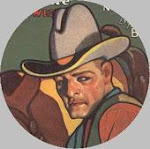Railroaded! was published as a BHW in
2001. I read the large print edition published in the Linford Western
Library in 2003.
Here's the cover blurb:
After the Civil War, Kansas was a wild territory ripe for exploitation German immigrant Helmut Rapp and his wife come west, claiming land under the Homestead Act. With the new railroad thrusting towards his land, Helmut strives to preserve the life and obscurity he has worked hard to achieve.
Mark notes in his interview that he's a
fan of Ernest Haycox. His well-crafted sentences, the details he uses
to build his characters, and the descriptions of events
all provide proof that he's studied Haycox's finer works. There is a
pulse and rhythm to Bannerman's narrative that demonstrates his
attention to his storytelling craft.
His structuring of the novel provides a
nice example. Most BHWs I've read offer a linear narrative, building
from a traditional exposition of place and setting, introducing
characters, and then adding the points of conflict from A to B to C.
In Railroaded!, Bannerman opens with a
dramatic scene spotlighting the primary character in mortal danger,
then moves to a deep flashback, so that the narrative keeps moving forward
to the point at which the novel opened—not the climax, but quite
near it. Building his novel with this structure displays Bannerman's
confidence in his skills and his awareness of how to place the
load-bearing structures in a plot.
This story is an emigrant tale: Helmut
Rapp's story begins in Bavaria, where – as a starstruck and
somewhat naïve youth -- he marries stage star Ingrid. Ingrid
continues to bed other men, and when Helmut discovers her continual
infidelity and lack of remorse, he takes his savings and goes to
America. He meets a resourceful Irish girl and marries her, sure that
his past will not catch up to him.
Of course, how wrong he turns out to be introduces all
kinds of conflict into the plot.
After he successfully builds a ranch in
the west, Ingrid tracks him down and extorts him into signing over
ownership of the farm to her. In return, she won't reveal that Helmut
is a bigamist. She opens a brothel in town and lives the high life of
a wild west entrepreneurial bordello queen.
Helmut's troubles grow exponentially
when the railroad arrives and wants to buy his valley to make its way
to the nearby town. The townspeople want Helmut to sell, because the
railroad will bring money to the town's businesses. Helmut could be
rich. But Ingrid holds the paper on his property, so he stands his
ground and refuses to sell – even though the ground he stands on
doesn't legally belong to him.
Conflict escalates until the reader
returns to the first scene, where Helmut is on the run from the local
marshal, a bloodthirsty gunman named Keno who doesn't mind if the
line of the law wobbles a bit in favor of the railroad.
In terms of storytelling finesse, this
is one of the best BHWs I've read. Bannerman demonstrates an expert
hand at pacing and storytelling. Recommended.
LINKS:
Railroaded! is available from Amazon. Click here for a large print edition. Click here for the Kindle edition..







